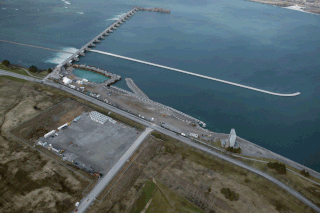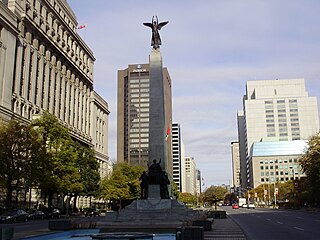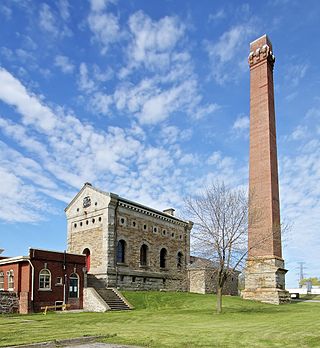
Sir Adam Beck was a Canadian politician and hydroelectricity advocate who founded the Hydro-Electric Power Commission of Ontario.

Queen's Park is an urban park in Downtown Toronto, Ontario, Canada. Opened in 1860 by Edward, Prince of Wales, it was named in honour of Queen Victoria. The park is the site of the Ontario Legislative Building, which houses the Legislative Assembly of Ontario. The phrase "Queen's Park" is regularly used as a metonym for the Government of Ontario or the Legislative Assembly of Ontario.

Queenston is a compact rural community and unincorporated place 5 kilometres (3.1 mi) north of Niagara Falls in the Town of Niagara-on-the-Lake, Ontario, Canada. It is bordered by Highway 405 to the south and the Niagara River to the east; its location at the eponymous Queenston Heights on the Niagara Escarpment led to the establishment of the Queenston Quarry in the area. Across the river and the Canada–US border is the village of Lewiston, New York. The Lewiston-Queenston Bridge links the two communities. This village is at the point where the Niagara River began eroding the Niagara Escarpment. During the ensuing 12,000 years the Falls cut an 11 kilometres (6.8 mi) long gorge in the Escarpment southward to its present-day position.

Ontario Hydro, established in 1906 as the Hydro-Electric Power Commission of Ontario, was a publicly owned electricity utility in the Province of Ontario. It was formed to build transmission lines to supply municipal utilities with electricity generated by private companies already operating at Niagara Falls, and soon developed its own generation resources by buying private generation stations and becoming a major designer and builder of new stations. As most of the readily developed hydroelectric sites became exploited, the corporation expanded into building coal-fired generation and then nuclear-powered facilities. Renamed as "Ontario Hydro" in 1974, by the 1990s it had become one of the largest, fully integrated electricity corporations in North America.

University Avenue is a major north–south road in Downtown Toronto, Ontario, Canada. Beginning at Front Street West in the south, the thoroughfare heads north to end at College Street just south of Queen's Park. At its north end, the Ontario Legislative Building serves as a prominent terminating vista. Many of Toronto's most important institutions are located along the eight-lane wide street such as Osgoode Hall and other legal institutions, the Four Seasons Centre, major hospitals conducting research and teaching, and landmark office buildings for the commercial sector, notably major financial and insurance industry firms. The portion of University Avenue between Queen Street West and College Street is laid out as a boulevard, with several memorials, statues, gardens, and fountains concentrated in a landscaped median dividing the opposite directions of travel, giving it a ceremonial character.
King's Highway 405, also known as Highway 405 and the General Brock Parkway, is a 400-Series Highway in the Canadian province of Ontario connecting the Queen Elizabeth Way (QEW) near St. Catharines with the Lewiston–Queenston Bridge in the village of Queenston. It then crosses the Niagara River, where it encounters the international border with the United States and continues into New York as Interstate 190 (I-190).
Dr. Richard Lankaster Hearn, OC was one of the key players in the establishment of Ontario’s energy system.

Sir William Howard Hearst, was the seventh premier of Ontario from 1914 to 1919.

Robert Hood Saunders, CBE, QC was mayor of Toronto from 1945 to 1948, President of the Canadian National Exhibition, chairman of the Ontario Hydro. He was also a member of the Orange Order in Canada.
The Niagara Parkway, formerly known as Niagara Boulevard and historically as the Niagara Road, is a scenic road in the province of Ontario that travels on the Canadian side of the Niagara River from the town of Fort Erie to Niagara-on-the-Lake. The portion north of Table Rock in the city of Niagara Falls is designated as an Ontario Scenic Highway. Niagara Boulevard originally referred only to the section from Fort Erie to Chippawa.

Sir Adam Beck Hydroelectric Generating Stations are two hydroelectric generating stations in Niagara Falls, Ontario, Canada. Sir Adam Beck Generating Station I, Sir Adam Beck Generating Station II and the Sir Adam Beck Pump Generating Station are all owned by Ontario Power Generation. Following the development of several smaller generating stations around Niagara Falls in the late 19th and early 20th centuries, the Province of Ontario authorized the construction of the first major publicly owned generating station in the province. At the time it was built, it was the largest hydroelectric generating station in the world.

The Niagara Tunnel Project was part of a series of major additions to the Sir Adam Beck hydroelectric generation complex in Niagara Falls, Ontario, Canada.

Emanuel Otto Hahn was a German-born Canadian sculptor and coin designer. He taught and later married Elizabeth Wyn Wood. He co-founded and was the first president of the Sculptors' Society of Canada.

The South African War Memorial is a memorial located at University Avenue and Queen Street West in Toronto, Ontario, Canada.

Frances Norma Loring LL. D. was a Canadian sculptor.

The Toronto Power Generating Station is a former generating station located along the Niagara River in Niagara Falls, Ontario, Canada, slightly upstream from the newer Rankine power station. Completed in 1906 in the Beaux-Arts-style, the station was designed by architect E. J. Lennox and was built by the Electrical Development Company of Ontario (owned by William Mackenzie, Frederic Thomas Nicholls, and Henry Mill Pellatt) under supervision of Hugh L. Cooper to supply hydro-electric power to nearby Toronto, Ontario.

The Hamilton Waterworks, also known as the Hamilton Waterworks Pumping Station, is a National Historic Site of Canada located in Hamilton, Ontario. It is an industrial water works structure built in the Victorian style, and a rare example of such a structure in Canada to be "architecturally and functionally largely intact". It is currently used to house the Museum of Steam and Technology.
Henry Girdlestone Acres (1880-1945) was a hydroelectric engineer from St. Catharines, Canada.















